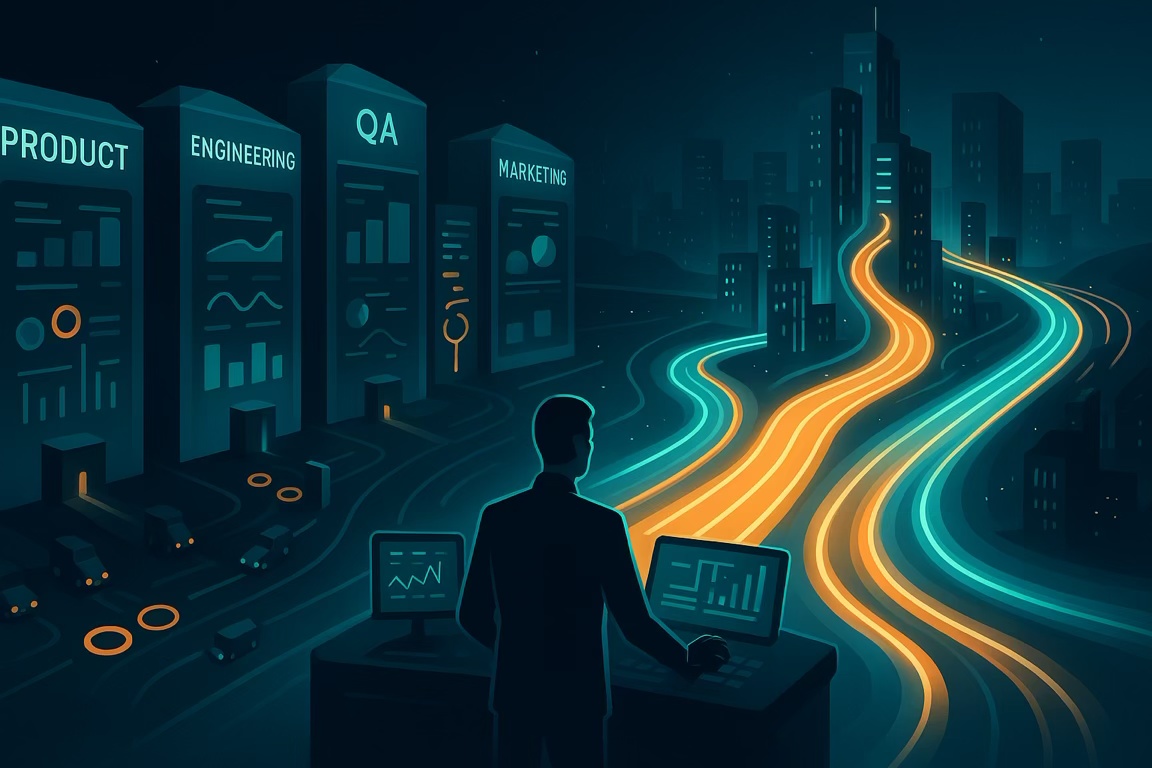A common paradox observed in modern organizations is the state of project dashboards glowing green while key business indicators are in the red. Teams consistently meet their deadlines, yet the organization’s time-to-market lags significantly behind the competition.
This is not a random contradiction but a diagnosable symptom. It is the classic sign of a system focused on the efficiency of its individual parts rather than the effective flow of value across the entire organization. The root cause is a foundational reliance on an outdated, project-centric mindset. The solution requires a strategic evolution in leadership: from Project Manager to Value Stream Architect.
Diagnosing the “Green Dashboard Fallacy”
This fallacy originates from “local optimization”—a systems-thinking trap where individual departments become hyper-efficient at their specific tasks, often to the detriment of the overarching business goal.
Consider a typical workflow that illustrates this dysfunction:
- The Product team defines success by the detailed specification they hand off.
- The Engineering team measures success by shipping code to QA on schedule.
- The Quality Assurance (QA) team is, in turn, measured by the number of bugs they find, creating rework loops and systemic bottlenecks.
- Finally, the Marketing team, engaged late in the process, rushes to execute a campaign to meet a launch date set months prior.
The result is a scenario where each functional manager reports success, while the end product is delayed, disconnected, and fails to meet market needs. Individual projects succeed, but customer value delivery fails.
The Strategic Shift: From Project Management to Value Stream Architecture
The antidote is to cease managing isolated projects and begin architecting end-to-end value streams. A value stream encompasses every step—from initial concept to customer delivery—including the often-invisible wait times between each stage.
This represents a profound strategic reorientation:
| Project Manager Mindset (Output-Focused) | Value Stream Architect Mindset (Outcome-Focused) |
| Objective: On-time, on-budget project completion. | Objective: Maximize the continuous flow of value. |
| Focus: Tasks, deadlines, scope management. | Focus: Flow, constraints, and wait time. |
| View: A temporary project or phase. | View: The end-to-end, persistent delivery system. |
| Metric: Project delivered. | Metric: Business outcomes, customer satisfaction. |
A useful analogy is to consider urban traffic. The Project Manager ensures each car is built to perfection. The Value Stream Architect designs the entire traffic system—the highways, signals, and intersections—to ensure a smooth, rapid flow of traffic. The focus shifts from the individual components to the performance of the overall system.
Anticipating and Navigating Systemic Friction
This transition predictably encounters systemic challenges that must be managed:
- Entrenched Silos: Departmental budgets and performance reviews often incentivize siloed behavior, creating resistance to cross-functional collaboration. These are legacy structures from industrial-era organizational design ill-suited for knowledge work.
- The Invisible Enemy of Waste: In knowledge work, the most significant source of delay is invisible: wait time. The time a work item spends in a queue is the primary form of waste, and making it visible is the first major hurdle.
- Dependence on Flawed Metrics: Organizations become reliant on familiar output metrics like “on-time delivery” because they provide an illusion of control. Shifting leadership to more meaningful flow metrics requires persistent education and a change in how success is measured.
The Architect’s Framework for Implementation
This is a strategic journey, not an overnight fix. The following steps provide a proven, methodical approach to begin the transition.
1. Visualize the System
One cannot improve what one cannot see. The first step is Value Stream Mapping (VSM). This diagnostic tool involves gathering representatives from every function to map every step in the process. The most critical insights are found in the gaps between the steps—this is where delays that kill velocity reside.
2. Redefine Performance Metrics
The central conversation must shift from, “Is the project on schedule?” to, “Where is value stuck?” This requires changing the organizational scoreboard from project-centric metrics to flow metrics:
- Lead Time: This is the north-star metric. It measures the total time from a customer request to the delivery of value.
- Work In Process (WIP) Limits: This is the most powerful lever for increasing speed. By limiting the amount of concurrent work, the system is forced to complete items faster.
3. Engineer Cross-Functional Flow
The architect’s role is to act as the connective tissue between departments. Instead of merely checking status, they facilitate the conversations needed to resolve bottlenecks. They must champion the creation of durable, long-lived teams organized around a specific value stream (e.g., “new customer onboarding”) rather than temporary project teams.
By adopting the architect’s mindset, leaders evolve from managers of tasks into engineers of a resilient and responsive organization. The objective is no longer simply to complete projects, but to build a powerful engine for continuous value delivery.
Discover more from HogoFlow
Subscribe to get the latest posts sent to your email.
